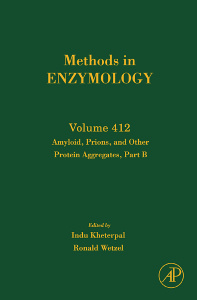Description
Amyloid, Prions, and Other Protein Aggregates, Part B
Author: WETZEL Ronald
Language: English
Subjects for Amyloid, Prions, and Other Protein Aggregates, Part B:
Publication date: 10-2006
430 p. · 15x22.8 cm · Hardback
430 p. · 15x22.8 cm · Hardback
Description
/li>Contents
/li>Readership
/li>Comment
/li>
The ability of polypeptides to form alternatively folded, polymeric structures such as amyloids and related aggregates is being increasingly recognized as a major new frontier in protein research. This new volume of Methods in Enzymology along with Part C (volume 413) on Amyloid, Prions and other Protein Aggregates continue in the tradition of the first volume (309) in containing detailed protocols and methodological insights, provided by leaders in the field, into the latest methods for investigating the structures, mechanisms of formation, and biological activities of this important class of protein assemblies.
Characterization of protein deposition in vivo and ex vivo.
Chapter 1: PMCA for diagnosis and prion propagation studies.
Chapter 2: Fractionation of prion protein aggregates by asymmetrical flow field-flow fractionation.
Chapter 3: Analysis of Amyloid Aggregates Using Agarose Gel Electrophoresis.
Chapter 4: Characterization of Systemic Amyloid Deposits by Mass Spectrometry.
Chapter 5: Proteomics of Polyglutamine Aggregates.
Chapter 6: Merger of Laser Capture Microdissection and Mass Spectrometry: A Window into the Amyloid Plaque Proteome.
Chapter 7: MALDI MS Imaging of Amyloid.
Chapter 8: Imaging polyglutamine deposits in brain tissue.
Chapter 9: X-34 labeling of abnormal protein aggregates during the progression of Alzheimer’s disease.
Chapter 10: Visualizing Pathology Deposits in the Living Brain of Alzheimer’s Disease Patients.
Chapter 11: Micro-Imaging of Amyloid in Mice
Cell and animal models of amyloid formation and toxicity
Chapter 12: An efficient protein transformation protocol for introducing prions into yeast.
Chapter 13: Screening for genetic modifiers of amyloid toxicity in yeast.
Chapter 14: Searching for anti-prion compounds: Cell-based high-throughput in vitro assays and animal testing strategies.
Chapter 15: A Drosophila Model of Alzheimer’s Disease.
Chapter 16: A C. elegans model of polyglutamine disease.
Computational Approaches and Theory
Chapter 17: Nucleation: the Connections between Equilibrium and Kinetic Behavior.
Chapter 18: Computational Approaches to Amyloid beta Fibril Core Structure.
Chapter 19: Amyloid beta-protein aggregations: Ab initio discrete molecular dynamics approaches.
Chapter 20: Computational approaches to fibril structure and formation
Chapter 1: PMCA for diagnosis and prion propagation studies.
Chapter 2: Fractionation of prion protein aggregates by asymmetrical flow field-flow fractionation.
Chapter 3: Analysis of Amyloid Aggregates Using Agarose Gel Electrophoresis.
Chapter 4: Characterization of Systemic Amyloid Deposits by Mass Spectrometry.
Chapter 5: Proteomics of Polyglutamine Aggregates.
Chapter 6: Merger of Laser Capture Microdissection and Mass Spectrometry: A Window into the Amyloid Plaque Proteome.
Chapter 7: MALDI MS Imaging of Amyloid.
Chapter 8: Imaging polyglutamine deposits in brain tissue.
Chapter 9: X-34 labeling of abnormal protein aggregates during the progression of Alzheimer’s disease.
Chapter 10: Visualizing Pathology Deposits in the Living Brain of Alzheimer’s Disease Patients.
Chapter 11: Micro-Imaging of Amyloid in Mice
Cell and animal models of amyloid formation and toxicity
Chapter 12: An efficient protein transformation protocol for introducing prions into yeast.
Chapter 13: Screening for genetic modifiers of amyloid toxicity in yeast.
Chapter 14: Searching for anti-prion compounds: Cell-based high-throughput in vitro assays and animal testing strategies.
Chapter 15: A Drosophila Model of Alzheimer’s Disease.
Chapter 16: A C. elegans model of polyglutamine disease.
Computational Approaches and Theory
Chapter 17: Nucleation: the Connections between Equilibrium and Kinetic Behavior.
Chapter 18: Computational Approaches to Amyloid beta Fibril Core Structure.
Chapter 19: Amyloid beta-protein aggregations: Ab initio discrete molecular dynamics approaches.
Chapter 20: Computational approaches to fibril structure and formation
Biochemists, cell biologists, neuroscientists, and related fields engaged in protein research.
- Presents detailed protocols
- Includes troubleshooting tips
- Provides coverage on structural biology, computational methods, and biology
© 2024 LAVOISIER S.A.S.
These books may interest you

Lipids in Protein Misfolding 168.79 €

Lipids in Protein Misfolding 147.88 €


